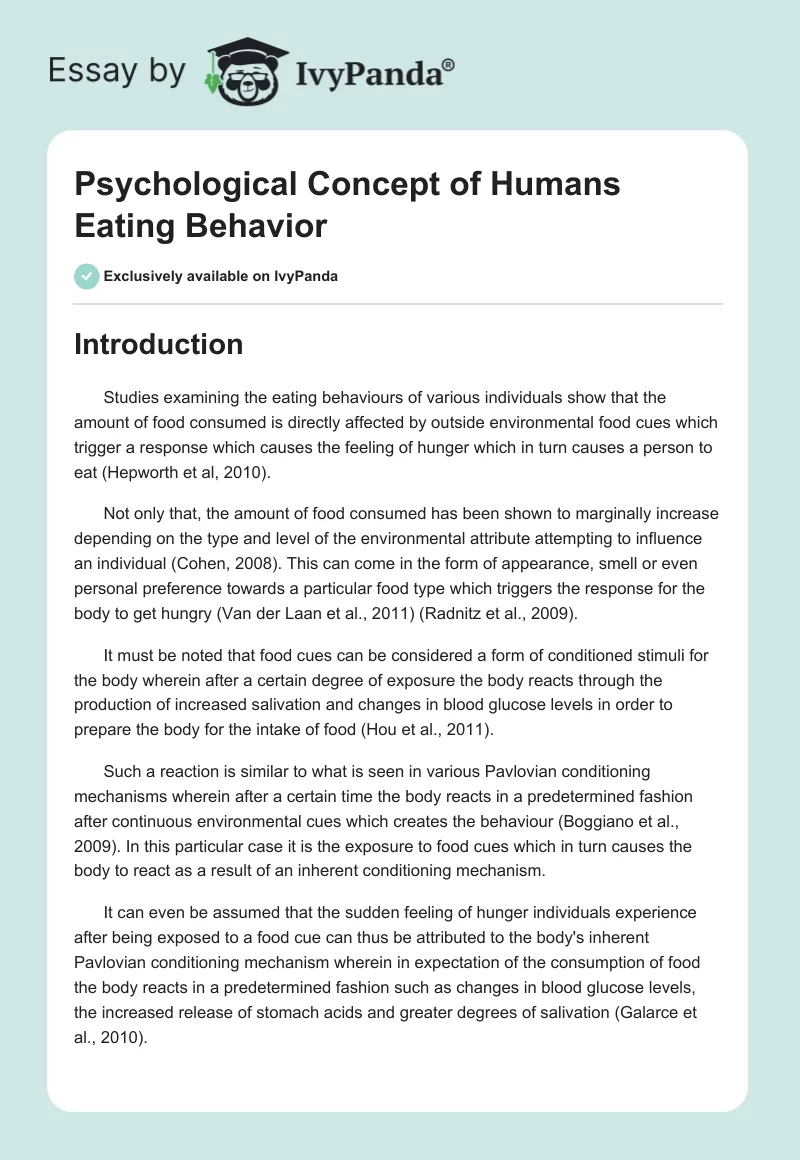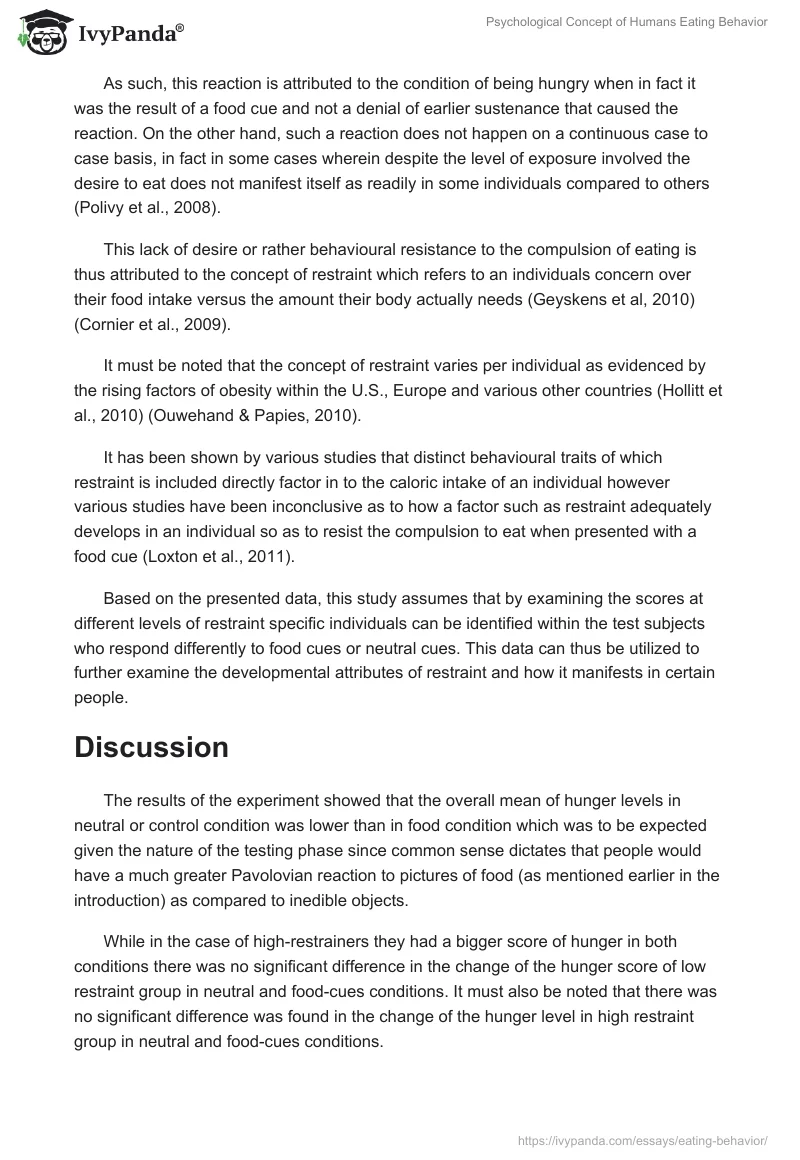Introduction
Studies examining the eating behaviours of various individuals show that the amount of food consumed is directly affected by outside environmental food cues which trigger a response which causes the feeling of hunger which in turn causes a person to eat (Hepworth et al, 2010).
Not only that, the amount of food consumed has been shown to marginally increase depending on the type and level of the environmental attribute attempting to influence an individual (Cohen, 2008). This can come in the form of appearance, smell or even personal preference towards a particular food type which triggers the response for the body to get hungry (Van der Laan et al., 2011) (Radnitz et al., 2009).
It must be noted that food cues can be considered a form of conditioned stimuli for the body wherein after a certain degree of exposure the body reacts through the production of increased salivation and changes in blood glucose levels in order to prepare the body for the intake of food (Hou et al., 2011).
Such a reaction is similar to what is seen in various Pavlovian conditioning mechanisms wherein after a certain time the body reacts in a predetermined fashion after continuous environmental cues which creates the behaviour (Boggiano et al., 2009). In this particular case it is the exposure to food cues which in turn causes the body to react as a result of an inherent conditioning mechanism.
It can even be assumed that the sudden feeling of hunger individuals experience after being exposed to a food cue can thus be attributed to the body’s inherent Pavlovian conditioning mechanism wherein in expectation of the consumption of food the body reacts in a predetermined fashion such as changes in blood glucose levels, the increased release of stomach acids and greater degrees of salivation (Galarce et al., 2010).
As such, this reaction is attributed to the condition of being hungry when in fact it was the result of a food cue and not a denial of earlier sustenance that caused the reaction. On the other hand, such a reaction does not happen on a continuous case to case basis, in fact in some cases wherein despite the level of exposure involved the desire to eat does not manifest itself as readily in some individuals compared to others (Polivy et al., 2008).
This lack of desire or rather behavioural resistance to the compulsion of eating is thus attributed to the concept of restraint which refers to an individuals concern over their food intake versus the amount their body actually needs (Geyskens et al, 2010) (Cornier et al., 2009).
It must be noted that the concept of restraint varies per individual as evidenced by the rising factors of obesity within the U.S., Europe and various other countries (Hollitt et al., 2010) (Ouwehand & Papies, 2010).
It has been shown by various studies that distinct behavioural traits of which restraint is included directly factor in to the caloric intake of an individual however various studies have been inconclusive as to how a factor such as restraint adequately develops in an individual so as to resist the compulsion to eat when presented with a food cue (Loxton et al., 2011).
Based on the presented data, this study assumes that by examining the scores at different levels of restraint specific individuals can be identified within the test subjects who respond differently to food cues or neutral cues. This data can thus be utilized to further examine the developmental attributes of restraint and how it manifests in certain people.
Discussion
The results of the experiment showed that the overall mean of hunger levels in neutral or control condition was lower than in food condition which was to be expected given the nature of the testing phase since common sense dictates that people would have a much greater Pavolovian reaction to pictures of food (as mentioned earlier in the introduction) as compared to inedible objects.
While in the case of high-restrainers they had a bigger score of hunger in both conditions there was no significant difference in the change of the hunger score of low restraint group in neutral and food-cues conditions. It must also be noted that there was no significant difference was found in the change of the hunger level in high restraint group in neutral and food-cues conditions.
Finally a significant finding of the study was that the hunger score of high-restrainers’ had increased significantly more than in low- restrainers’ group. Based on the results of the study it can be seen that the experiment showed no significant difference in high- and low-restrainers’ hunger rating in neutral- and food-cue presentations.
An examination of various studies involving food cues reveals that the reason behind the results of the study can be connected to the type of food cue used to illicit a response from the subject (Loxton et al., 2011).
In other experiments it was shown that by utilizing both visual and olfactory senses in order to stimulate the subject a greater degree of rating difference was seen between high and low restrainers. It was noted by the studies that while visual cues can be used as a method of eliciting a particular response the researchers found that using a blindfold test the participants exhibited a greater response in terms of smell as compared to visual stimuli (Hepworth et al, 2010).
On the other hand a combination of both resulted in a far greater degree of hunger rating. The reason behind this is attributed to the fact that human response mechanisms have different reactive traits based on the degree and type of stimuli involved.
Various marketing studies have shown that while visual representations do illicit a form of hunger, when other sensory mechanisms are included into the assessment the level of hunger actually increases (Brignell et al., 2009).
In fact the results of such studies have been implemented in various fast food establishments utilizing the “open kitchen” concept wherein the smells and visuals presented by the establishment help to increase the rate of hunger resulting in that particular person ordering more than initially intended (Geyskens et al, 2010).
It was also shown that static pictorial representations of food often times don’t do as well as compared to moving graphical representations hence the fact a majority of modern day food commercials often show the food being prepared and moving which has been shown to illicit a greater response (Schur et al., 2009).
It is assumed that the basis behind this particular response is due to the fact that food that is moving is thought to be more “real” for the audience. Static representations such as those seen in pictures have a less effective response due to the fact that the perception of the individual viewing the photo interprets it as nothing more than a mere photo (Forzan et al., 2010).
Conclusion
It can be assumed that when an individual is presented with either a static representation or a moving graphic visualization it can be expected that the latter will draw out a greater hunger response (Van der Laan et al., 2011).
While the research supported the hypothesis of a significant interaction which occurred in hunger levels between high- and low- restraint groups in control and test condition the fact remains that upon closer examination of the methods utilized in this particular study compared to others it is revealed that a mere static picture is an insufficient method of drawing out an appropriate response (Piech et al., 2010).
This evidenced by the fact that the experiment evidenced no significant difference in high- and low-restrainers’ hunger rating in neutral- and food-cue presentations. As such it is recommended for future studies utilizing the same principals to use food cues that stimulate more than one sense so as to get a more accurate level of distinction between hunger ratings.
References
Brignell, C, Griffiths, T, Bradley, B, & Mogg, K 2009, ‘Attentional and approach biases for pictorial food cues. Influence of external eating’, Appetite, 52, 2, pp. 299-306, Academic Search Complete, EBSCOhost.
Boggiano, M, Dorsey, J, Thomas, J, & Murdaugh, D 2009, ‘The Pavlovian power of palatable food: lessons for weight-loss adherence from a new rodent model of cue-induced overeating’, International Journal of Obesity, 33, 6, pp. 693-701, Academic Search Complete, EBSCOhost.
Cohen, DA 2008, ‘Obesity and the built environment: changes in environmental cues cause energy imbalances’, International Journal of Obesity, 32, pp. S137-S142, Academic Search Complete, EBSCOhost.
Cornier, M, Salzberg, A, Endly, D, Bessesen, D, Rojas, D, & Tregellas, J 2009, ‘The Effects of Overfeeding on the Neuronal Response to Visual Food Cues in Thin and Reduced-Obese Individuals’, PLoS ONE, 4, 7, pp. 1-7, Academic Search Complete, EBSCOhost.
Forzano, L, Chelonis, J, Casey, C, Forward, M, Stachowiak, J, & Wood, J 2010, ‘SELF-CONTROL AND IMPULSIVENESS IN NONDIETING ADULT HUMAN FEMALES: EFFECTS OF VISUAL FOOD CUES AND FOOD DEPRIVATION’, Psychological Record, 60, 4, pp. 587-607, Academic Search Complete, EBSCOhost.
Galarce, E, McDannald, M, & Holland, P 2010, ‘The basolateral amygdala mediates the effects of cues associated with meal interruption on feeding behavior’, Brain Research, 1350, pp. 112-122, Academic Search Complete, EBSCOhost.
Geyskens, K, Soetens, B, & Roets, A 2010, ‘Exposure Makes the Heart Grow Less Fond!: The Effects of Exposure to Palatable Foods on the Subsequent Attention Processing of Food Cues’, Journal of Health Psychology, 15, 2, pp. 230-238, Academic Search Complete, EBSCOhost.
Hepworth, R, Mogg, K, Brignell, C, & Bradley, B 2010, ‘Negative mood increases selective attention to food cues and subjective appetite’, Appetite, 54, 1, pp. 134-142, Academic Search Complete, EBSCOhost.
Hou, R, Mogg, K, Bradley, B, Moss-Morris, R, Peveler, R, & Roefs, A 2011, ‘External eating, impulsivity and attentional bias to food cues’, Appetite, 56, 2, pp. 424-427, Academic Search Complete, EBSCOhost.
Hollitt, S, Kemps, E, Tiggemann, M, Smeets, E, & Mills, J 2010, ‘Components of attentional bias for food cues among restrained eaters’, Appetite, 54, 2, pp. 309-313, Academic Search Complete, EBSCOhost.
Loxton, N, Dawe, S, & Cahill, A 2011, ‘Does negative mood drive the urge to eat? The contribution of negative mood, exposure to food cues and eating style’, Appetite, 56, 2, pp. 368-374, Academic Search Complete, EBSCOhost.
Ouwehand, C, & Papies, E 2010, ‘Eat it or beat it. The differential effects of food temptations on overweight and normal-weight restrained eaters’, Appetite, 55, 1, pp. 56-60, Academic Search Complete, EBSCOhost.
Piech, R, Pastorino, M, & Zald, D 2010, ‘All I saw was the cake. Hunger effects on attentional capture by visual food cues’, Appetite, 54, 3, pp. 579-582, Academic Search Complete, EBSCOhost.
Polivy, J, Herman, C, & Coelho, J 2008, ‘Caloric restriction in the presence of attractive food cues: External cues, eating, and weight’, Physiology & Behavior, 94, 5, pp. 729-733, Academic Search Complete, EBSCOhost.
Radnitz, C, Byrne, S, Goldman, R, Sparks, M, Gantshar, M, & Tung, K 2009, ‘Food cues in children’s television programs’, Appetite, 52, 1, pp. 230-233, Academic Search Complete, EBSCOhost.
Schur, E, Kleinhans, N, Goldberg, J, Buchwald, D, Schwartz, M, & Maravilla, K 2009, ‘Activation in brain energy regulation and reward centers by food cues varies with choice of visual stimulus’, International Journal of Obesity, 33, 6, pp. 653-661, Academic Search Complete, EBSCOhost.
Van der Laan, L, de Ridder, D, Viergever, M, & Smeets, P 2011, ‘The first taste is always with the eyes: A meta-analysis on the neural correlates of processing visual food cues’, NeuroImage, 55, 1, pp. 296-303, Academic Search Complete, EBSCOhost.


